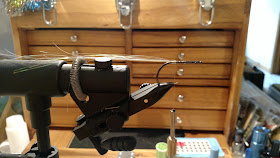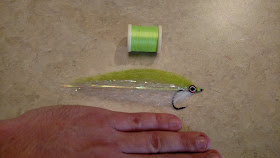Tying an SF Fiber Baitfish Fly
(In 2015 Grant tied a large batch of SF Baitfish flies for friend/guide/BPS Pro Staffer Harry Robertson to take to the Amazon. Those flies helped Harry's clients land many gorgeous Peacock Bass like the beauty pictured above!)
Materials:
Hook: Owner SSW 1/0-5/0
Thread(s): Monofilament tying thread for the body, 70 or 140 denier thread to match the top color of the fly
Body: SF Fibers in desired colors
Flash: Flashabou to match SF Fibers
Lateral Line: Holographic Flashabou or Lateral Scale
Eyes: Large 3D molded eyes
Glues: Sally Hansen Hard as Nails or equivalent head cement, Loctite GEL
Helpful tools: A rotary vise makes this fly much easier
Step 1: Start your monofilament thread on the hook and run it to the back. Monofilament thread is the best option for this fly because it lets the colors of the SF fiber show through.
Step 2: Tie in 2-3 strands of flashabou in your desired colors in the midpoint of the material, then fold it back and wrap over it. This helps make sure the material doesn’t slip.
Step 3: Take a thin clump of SF fiber in your desired color. Don’t use any more than what is pictured here. If you use much more than this, the fly will be very thick when finished and won’t fish correctly.
Step 4: Tie in the clump of fiber in the midpoint like we did with the flashabou and fold it back just the same. It should look similar to what is pictured here.
Step 5: It helps to have a rotary vise for this fly because you will have to flip the fly over after every step. Invert the fly and repeat step 4 and work the material around the hook.
Step 6: Repeat steps 4 and 5 until you reach just behind the eye of the hook. If you are planning on making a white bellied baitfish fly. I like to do all white material on the bottom and the first two ties of material on top. After the first two on top I begin tying in the color (in this case chartreuse. This helps make the fly appear more natural with just the right amount of color on top. Stop your materials about an eye width back from the hook eye.
Step 7: Whip finish off your mono thread. It helps to double whip finish this stuff because sometimes it likes to unravel. Add a dab of Sally Hansen and then start your colored thread right on top of the mono. I like to use the thin thread here because it prevents a large build up.
Step 8: Take about 4 strands of the holographic flashabou and tie them in in the center of the material on the near side of the fly right down the center. Then fold the material around the eye and run it down the center of the opposite side of the fly as well. This flash line serves as the lateral line for the fly.
Step 9: After tying in the flash down the sides, use your colored thread to cover up the mono thread entirely, as well as the tie in point for the flash. This builds a nice head that matches the top of the fly. Whip finish off and coat in Sally Hansen.
Step 10: I find it’s easiest to turn the fly on its side for this step. Use a drop of Loctite Gel right behind the thread head, on top of the flash we just tied in. Then push your large 3D molded eye onto the drop. The gel Loctite works best because it doesn’t run while you are getting the eye into position. Repeat on the opposite side of the fly. I like to coat the thread head again with Sally Hansen and to make sure to get a little bit back onto the eyes. This helps the durability of the fly.
Step 11: Trim the fly to your desired shape. I like to round the top and bottom of the fly symmetrically while letting it taper off. This is the typical size I tie these flies in.
And that’s it! These flies can be tied pretty quickly after a little practice. They are very durable and have been responsible for bringing many species of fish to my hands! There are endless color combinations that you could tie these flies in to match just about any baitfish in any environment. You can trim the material to any shape you desire as well. The SF fiber also accepts permanent marker very well and I like to add barring and dots to a lot of my flies. I have used this simple pattern to catch everything from Largemouth to Stripers and Redfish to even a few catfish. The material is long enough to where you could tie it in without folding to make flies large enough to target musky as well. Just about any predator species will happily demolish one of these that’s cast into its home waters. I hope this post will help you get creative with this easy to use material and create some really cool flies!
Tight Lines,
Grant Alvis





































